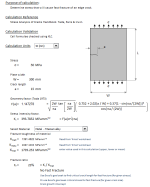Fast Fracture - Plate with an Edge Crack.xls
Description
The darker area characterised by beach marks shows how the crack has grown from repeated loading. This crack growth phenomenon is called fatigue. When the crack gets to a critical size the part suffers a sudden fast fracture through the remaining section. This stress intensity calculation determines the critical crack size for fast fracture for a selection of metals, ceramics, polymers and composites. The calculation works for the following systems of units Fundamental, SI, SI (mm), US Unit (ft) and US Unit (in).
Calculation Reference
Material Science and Engineering: An Introduction, 3rd Edition, William Calister
Mechanical Behavior of Materials: Engineering Methods for Deformation, Fracture, and Fatigue, Norman E. Dowling
Mechanical Behavior of Materials: Engineering Methods for Deformation, Fracture, and Fatigue, Norman E. Dowling
Physical Metallurgy Principles, Robert E. Reed-Hill
Fast fracture refers to the abrupt failure of a material due to the rapid propagation of a crack under stress conditions. This phenomenon is particularly crucial in the field of Fracture Mechanics, which studies the behavior of cracked structures and materials. Here’s a step-by-step description of the process:
1. Crack Initiation:
- Stress Concentration: When a material is subjected to stress, areas with imperfections or defects, such as micro-cracks or inclusions, experience a higher local stress concentration.
- Microscopic Flaws: These flaws or initial cracks can originate during the material's manufacturing process, or develop during its service life due to various mechanical, thermal, or chemical influences.
2. Crack Propagation:
- Fatigue: Under cyclic or fluctuating loads, the crack begins to grow gradually, a phenomenon known as fatigue crack growth. This is driven by the stress concentration at the crack tip and cyclic loading.
- Beach Marks: The crack growth can often be visualized through patterns known as beach marks or striations on the fracture surface, indicating the incremental advancement of the crack with each load cycle.
3. Critical Crack Size:
- Stress Intensity Factor: The stress intensity factor (SIF) quantifies the stress distribution around the crack tip. It is influenced by the applied stress, crack size, and geometry of the structure.
- Fracture Toughness: Every material has an inherent property known as fracture toughness, which is the critical stress intensity factor beyond which rapid crack propagation occurs.
- Critical Size: When the crack reaches a size where the SIF equals or exceeds the material’s fracture toughness, it is deemed to have reached the critical crack size.
4. Fast Fracture:
- Rapid Propagation: Once the critical crack size is attained, the crack propagates rapidly through the material, especially if it is under a high load or stress.
- Sudden Failure: The rapid crack propagation leads to a sudden and catastrophic failure of the component, known as a fast fracture.
- Fracture Surface: The resultant fracture surface may exhibit features like a smooth, mirror-like region (indicative of slow crack growth) transitioning to a rough, fibrous region (indicative of rapid, ductile fracture) or a cleavage facet (in brittle materials).
5. Consequences and Analysis:
- Structural Failure: Fast fracture can result in the sudden collapse or failure of a structure, which might be catastrophic, especially in critical applications like aerospace, automotive, or civil structures.
- Fractographic Analysis: Post-fracture, a detailed analysis of the fracture surface (fractography) is performed to understand the crack initiation site, propagation path, and failure mechanisms.
Importance of Understanding Fast Fracture:
Understanding and predicting fast fracture is vital for ensuring the safety and reliability of structures and components, especially those subjected to cyclic loads or operating in critical environments. Engineers utilize principles of fracture mechanics to design against fast fracture, by ensuring that cracks either do not initiate or do not propagate to a critical size during the intended service life of the component.
Calculation Preview
Full download access to any calculation is available to users with a paid or awarded subscription (XLC Pro).
Subscriptions are free to contributors to the site, alternatively they can be purchased.
Click here for information on subscriptions.



